LOSC Lille is an emerging club in France and has found a space amongst the good clubs in the country. Lille have been crowned champions of Ligue 1 three times in the club’s history, with the most recent title coming in the 2010/2011 season. A part of the club’s success in winning these and other titles comes from their very good academy which has produced some great talents such as Eden Hazard, Kevin Mirallas and Benjamin Pavard, who are now playing for big clubs like Real Madrid and Bayern Munich.
In this data analysis we will use data and statistics to find the best talents currently in Lille’s academy that could potentially take the step up, earn a place in the first-team, and experience Ligue 1 football.
Methodology
In order to make this analysis we need to establish what our data pool will be. Since Lille II is the only youth team that has data available on Wyscout for the 2019/2020 season, we must look at the players from that team but those who meet our required specifications.
Because Lille II play in National 2, a league that is not widely covered, the data available has its limitations, therefore, we will only highlight players who have played at least 450 minutes this season to make our analysis a more realistic one.
After analysing all the players we will compile a shortlist with the best talents.
Defending
Starting with the defensive statistics, we have created a scatter plot that shows us aerial duels won% and defensive duels won% on each axis. The size of the dots was set to display the amount of PAdj interceptions per 90 giving us a view of the most important defensive metrics.
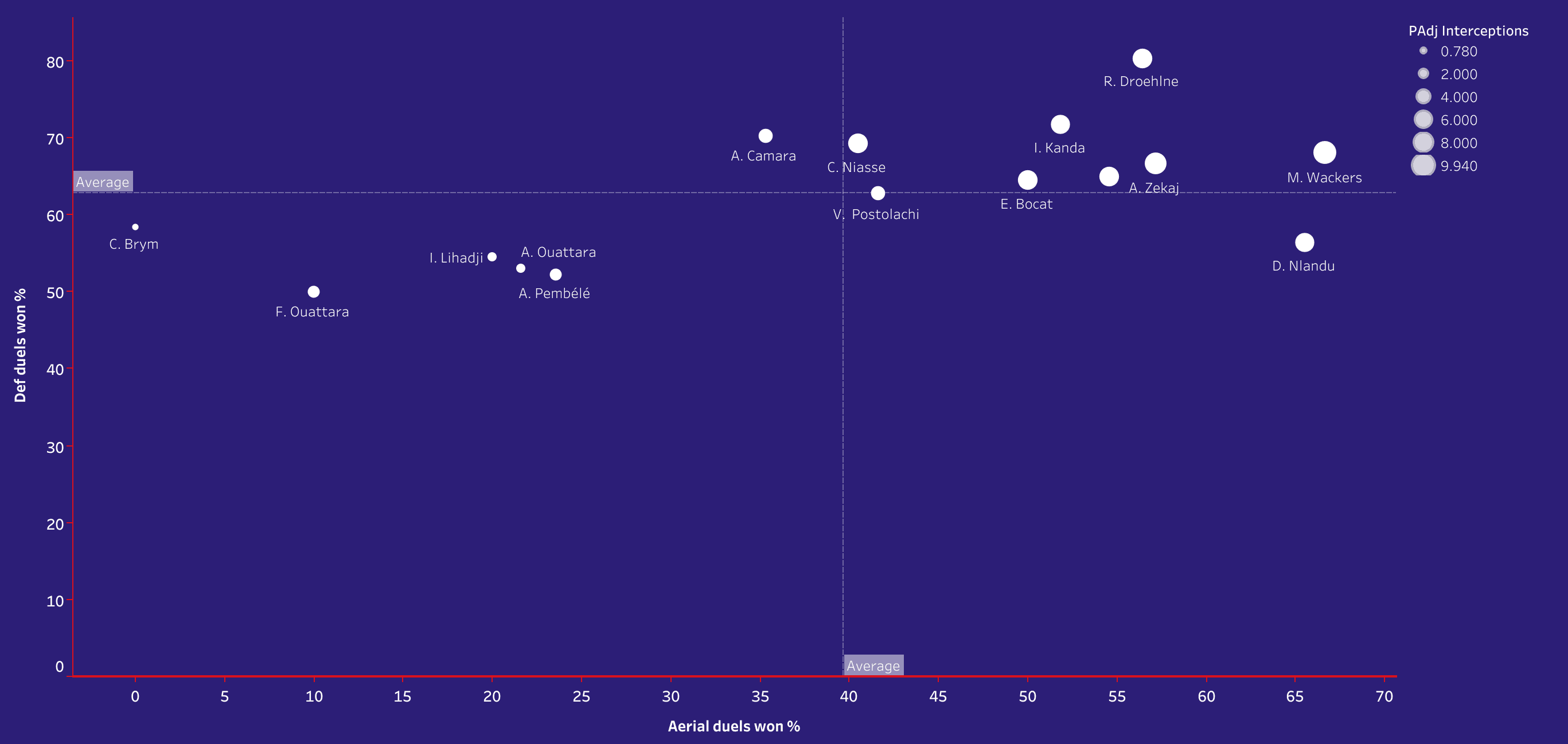
Looking at the graphic we can see that some players stand out and appear on the right upper quadrant, however, one player displays slightly better numbers than the others. Maxime Wackers is the player with the best numbers in this graph – he won 68.09% of his defensive duels and 66.7% of his aerial duels while also averaging 9.94 PAdj interceptions per 90 minutes. Arton Zekaj is another player who displays good numbers; the Serbian won 66.67% of his defensive duels, 57.14% of his aerial duels and averaged 8.95 PAdj interceptions per 90. With the best success numbers in the team when it comes to defensive duels, Ruben Droehnle pairs his impressive win rate of 80.36% with a 56.41% win rate when it comes to aerial duels while also boasting 7.32 PAdj interceptions per 90. Lastly, and although he is not in the upper right quadrant, Darly Nlandu appears with a high 65.52% win rate on his aerial duels but a slightly below average 56.31% win rate on his defensive duels.
Passing and ball progression
In this section we will take a look at the best passers in the team; the players who are able to circulate the ball and do it well. We will also take a look at the players that are the best at progressing the ball up the field through passing or carrying.
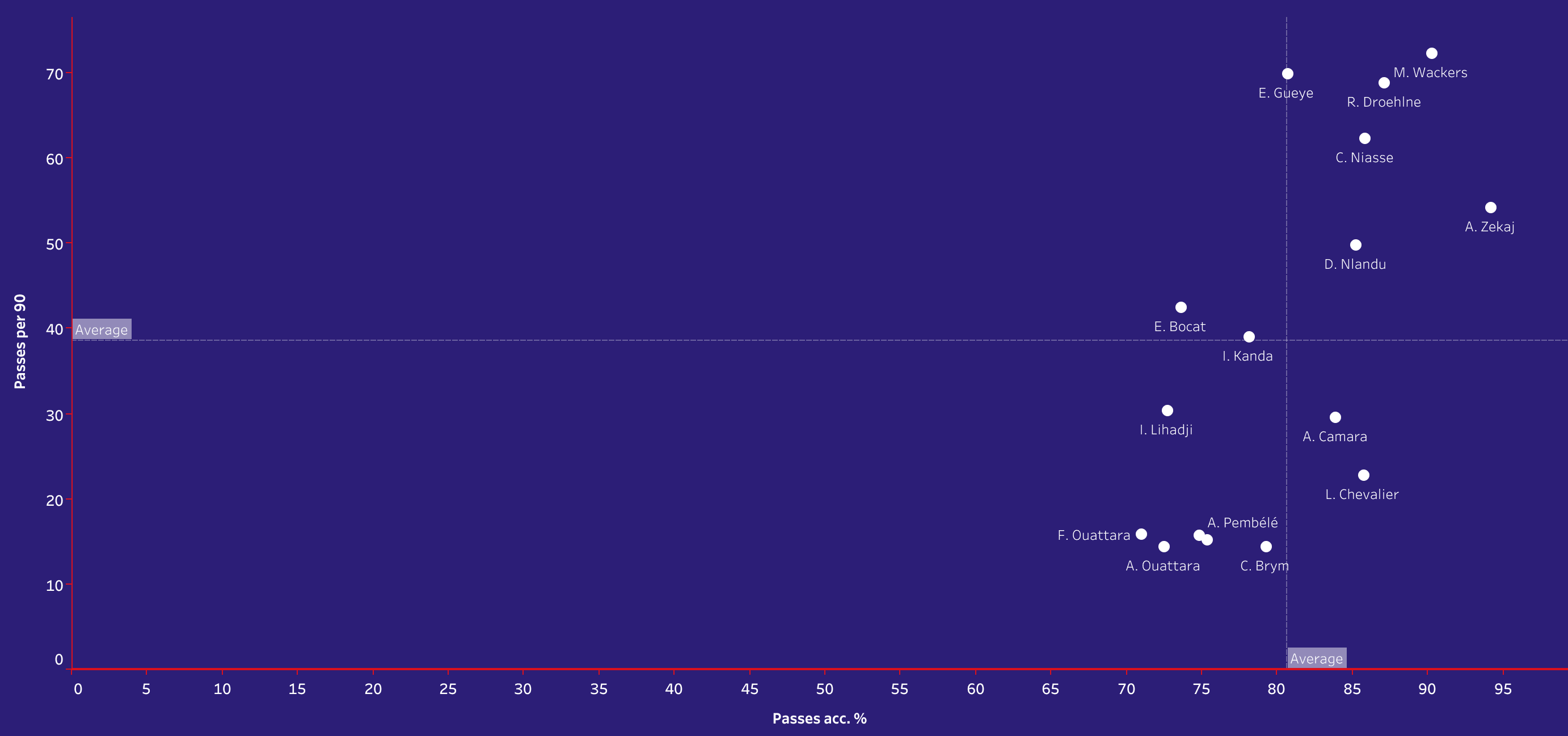
A few names stand out when looking at this first passing graphic, and many of them are already familiar faces. Arton Zekaj averaged 54.23 passes per 90 with a 94.24% completion rate, ranking first in this metric. Maxime Wackers has the next best ranking in this graphic with 72.25 passes per 90 and a 90.31% completion rate, followed by Ruben Droehnle with 68.84 passes per 90 and a 87.16% completion rate. Another familiar face that shows good numbers in this graphic is Darly Nlandu, he averages 49.77 passes per 90 with a 85.27% completion rate. The last player in the right upper quadrant that stands out is Cheikh Niasse, he averages 62.30 passes per 90 with a very good 85.88% completion rate.
The next scatter plot shows us the player’s ball progression capabilities.
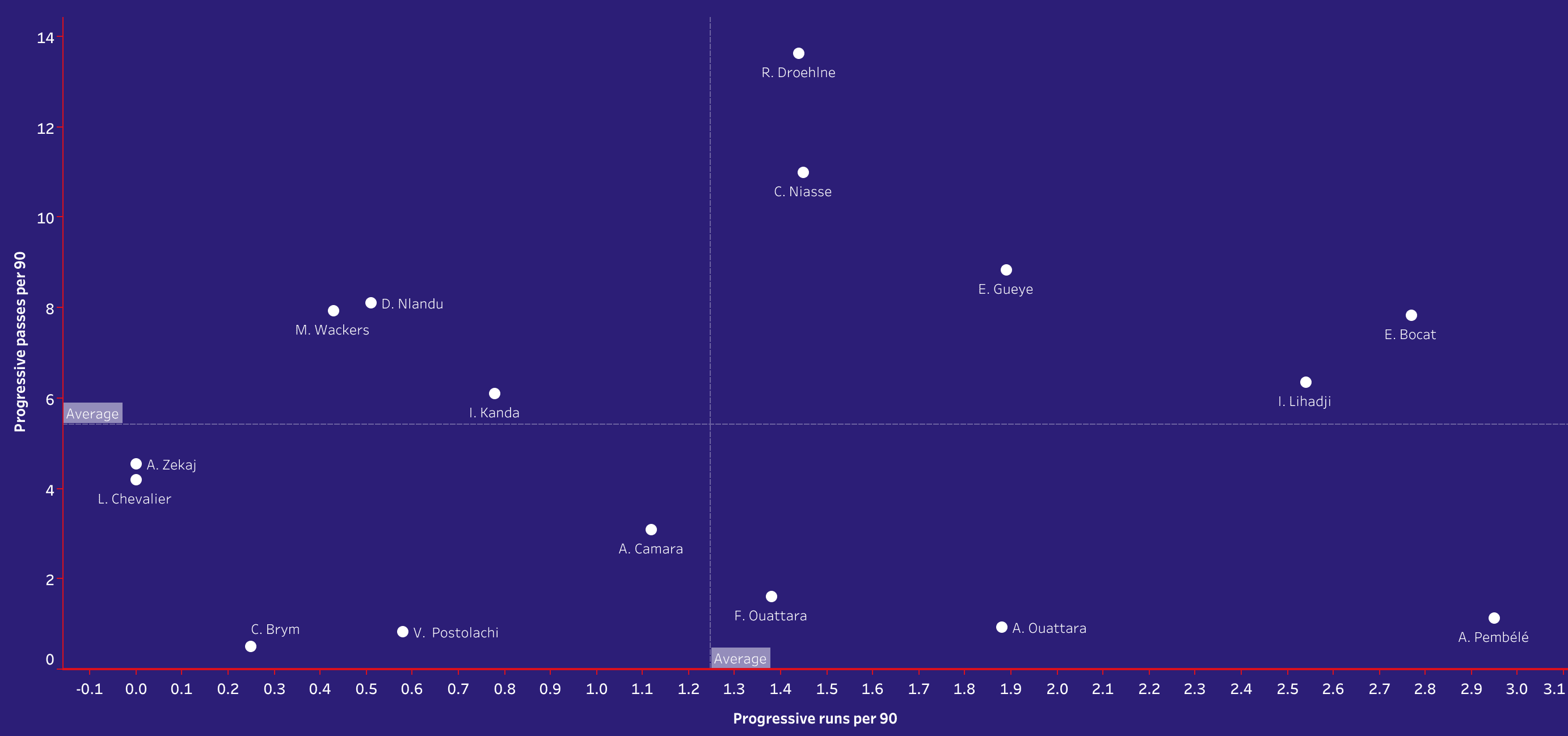
When looking at the graphic one player clearly stands out and that is Eric Bocat, however, the Frenchman completed a move to Royal Excel Mouscron and for that reason we will not consider him. The next player who stands out from the crowd is Isaac Lihadji, he averages 6.35 progressive passes per 90 and 2.54 progressive runs per 90. El Hadji Gueye appears with good numbers in the upper right quadrant, however, much like Eric Bocat, he completed a move to Royal Excel Mouscron and therefore we will not include him in the analysis. Two familiar faces appear in the right upper quadrant of the graphic, Ruben Droehnle comes in with 13.62 progressive passes per 90 and 1.44 progressive runs per 90 while Cheikh Niasse averages 10.98 progressive passes per 90 and 1.45 progressive runs per 90. Lastly, an honourable mention to Andy Pembelé who averages the highest number of progressive runs per 90 (2.95) but a low amount of progressive passes per 90 (1.13)
Chance creation and creativity
Moving to more offensive statistics, we will now take a look at the player’s chance creation abilities and creativity. For this next scatter plot we created the metrics “Dangerous passes per 90”, by adding passes to the final third per 90, deep completions per 90 and passes to the penalty area per 90, and “Chance creation contribution per 90” by adding third assists per 90, second assists per 90, assists per 90 and key passes per 90. An analysis of these metrics will give us a good view of the player’s contribution to creating chances.
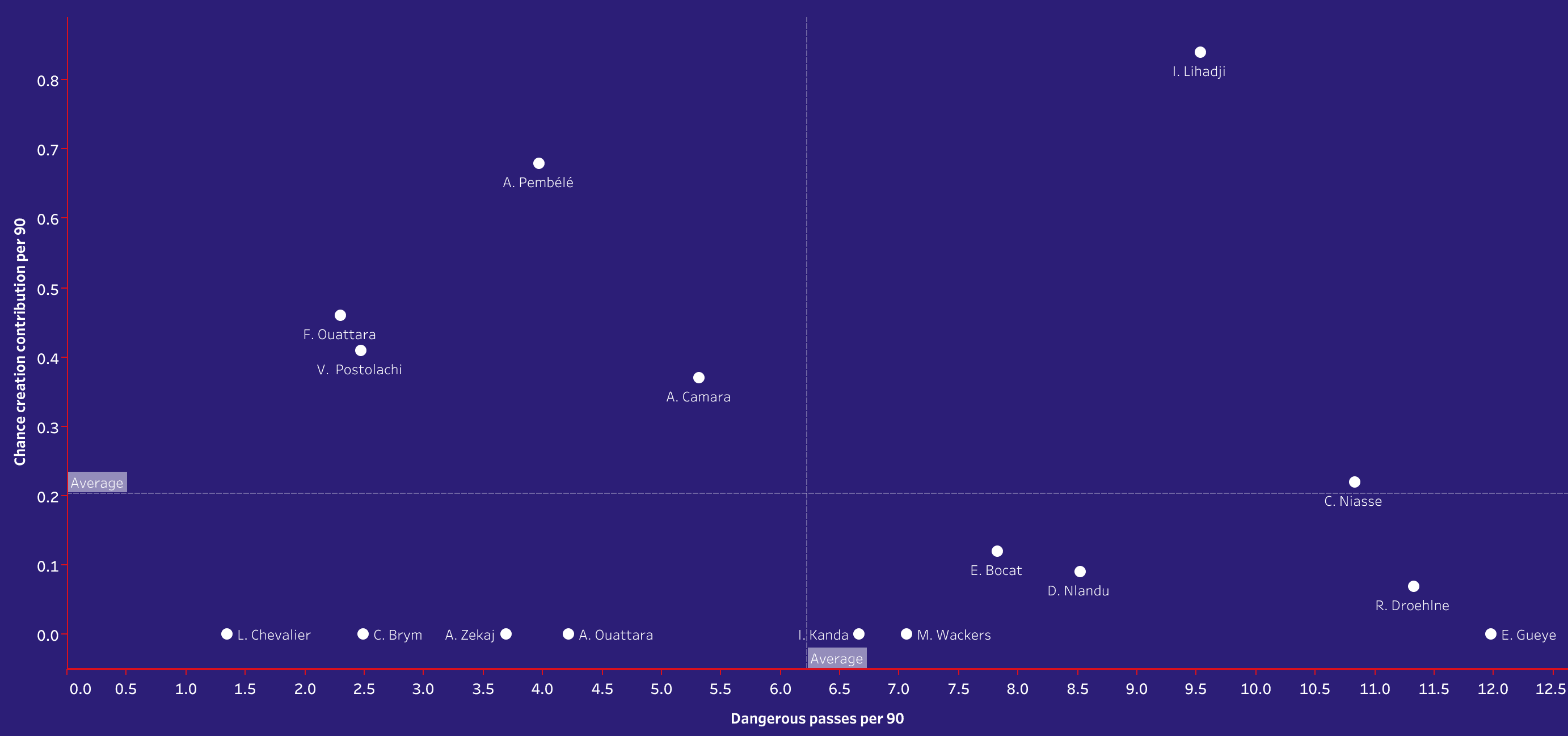
Looking at the players who already stood out in other sections, Isaac Lihadji is the player with the best record for these metrics. He averages 9.53 dangerous passes per 90 and has the best chance creation contribution per 90 with 0.84. Cheikh Niasse is another familiar face who comes in with good numbers in this graphic, the midfielder averages 10.83 dangerous passes per 90 which is a high number, however, he only contributes to the creation of 0.22 chances per 90 falling short on the standard set in the previous metric. Although not in the right upper quadrant, Andy Pembelé deserves a mention for his high chance creation contribution per 90 (0.68) which ranks him second in the metric. The striker displays a low number of dangerous passes per 90 (3.97) falling below the average for the team in this metric. The last mention goes to a player who already stood out in the previous sections, Ruben Droehnle, who ranks second in the team in terms of dangerous passes per 90 with 11.33 but only contributes to the creation of 0.07 chances per 90.
Goal Contribution
In this final section, its time to take a look at the goal contribution each player has made for the team, in order to do so, we created the metrics “Goal contribution per 90” by adding goals per 90 and assists per 90 and, “xG contribution per 90” by adding xGoals and xAssists per 90.
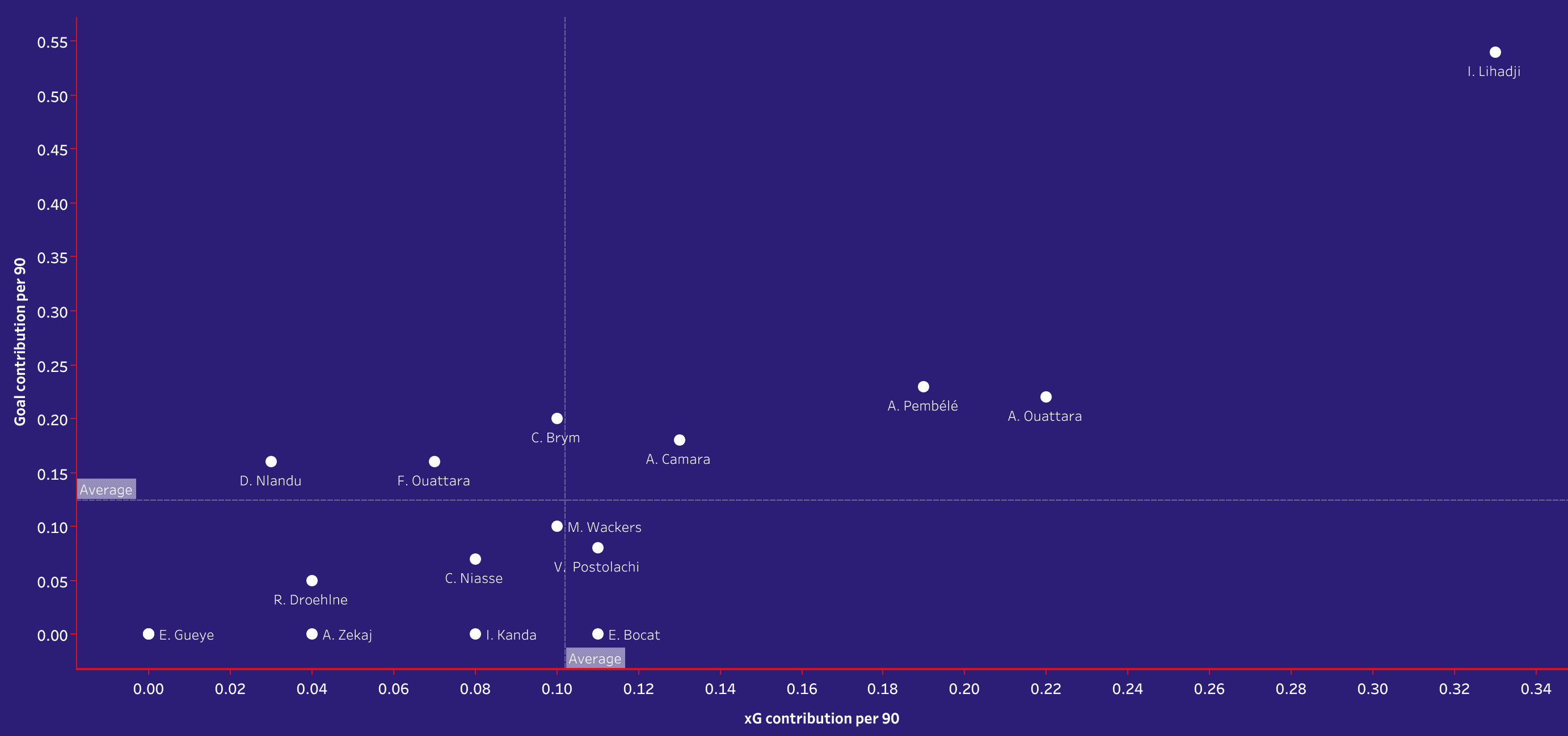
There is one clear outlier in this graphic and that is Isaac Lihadji. The young winger averages a goal contribution per 90 of 0.54 which largely surpasses his also high 0.33 xG contribution per 90 and ranks first in both metrics. Another familiar face appears in the right upper quadrant, therefore ranking above average in both metrics, and that is Andy Pembélé. He averages a goal contribution per 90 of 0.23 and an xG contribution per 90 of 0.19. With a similar but slightly better profile than the latter, Abou Ouattara is also a stand out player in this section but his move to Vitória SC in Portugal takes him out of the analysis since he is no longer part of the club. The last player who stands out in the graphic and shows good numbers is Aguibou Camara. The youngster from Guinea displays interesting numbers with a goal contribution per 90 of 0.18 and an xG contribution per 90 of 0.13.
Final Shortlist
Isaac Lihadji
Isaac Lihadji is an 18-year-old French winger who was signed from Olympique Marseille B this season. He is included in this analysis because of his youth as well as is inclusion in Lille’s second team. Lihadji stood out during our analysis in the creativity, ball progression and goal contribution sections with the best numbers in all three. Check his percentile ranks chart below to see what other metrics he ranks well in.
Standout attributes
- Chance creation
- Goalscoring
- Ball progression
- Crossing
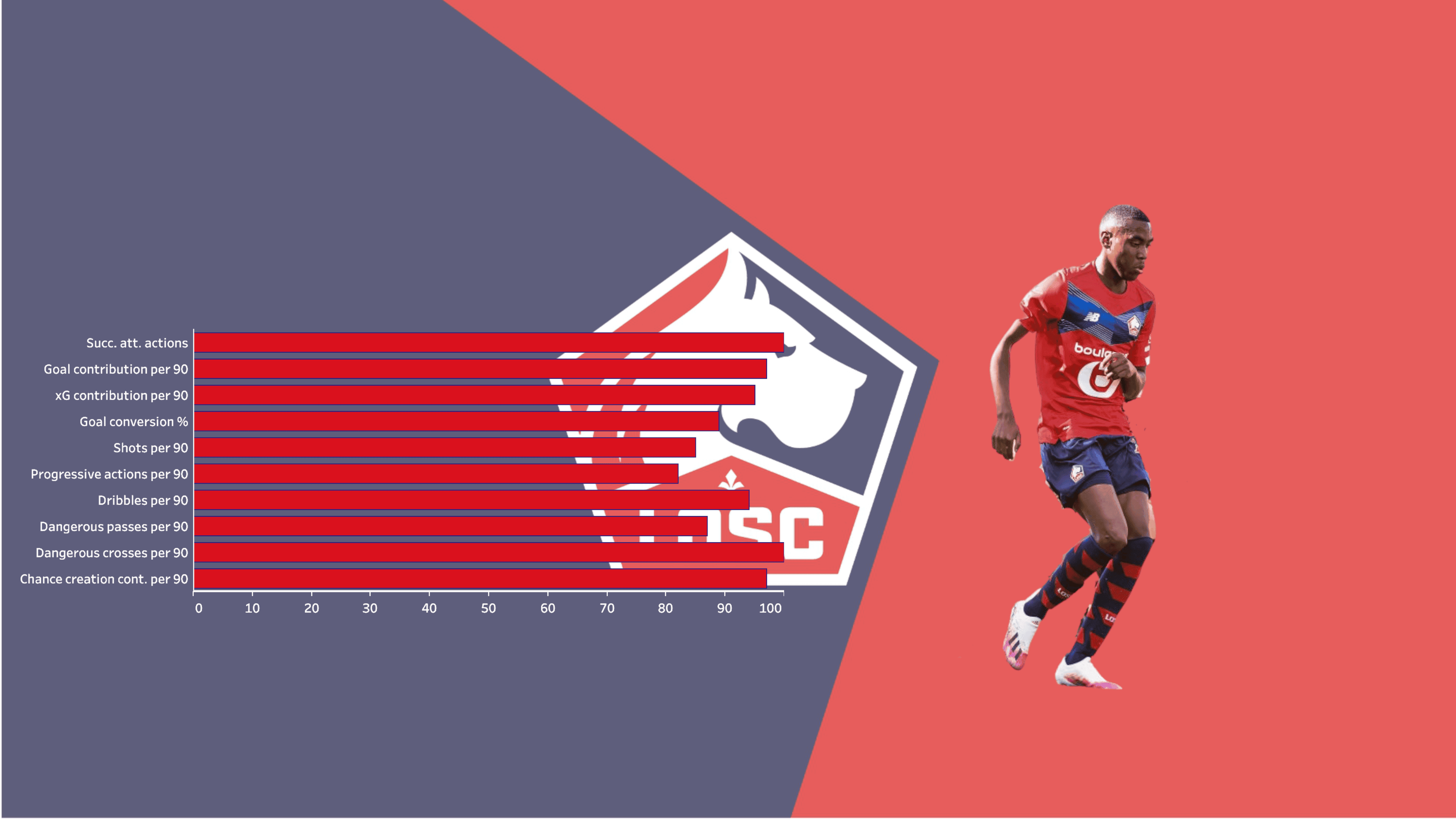
Andy Pembélé
Andy Pembélé is a 20-year-old French forward who can also play as a winger. During our analysis Pembélé displayed good numbers in the creativity, ball progression and goal contribution sections and was the best offensive player behind Lihadji. Check his percentile ranks chart below to see what other metrics he ranks well in.
Standout attributes
- Chance creation
- Goalscoring
- Ball progression
- Crossing
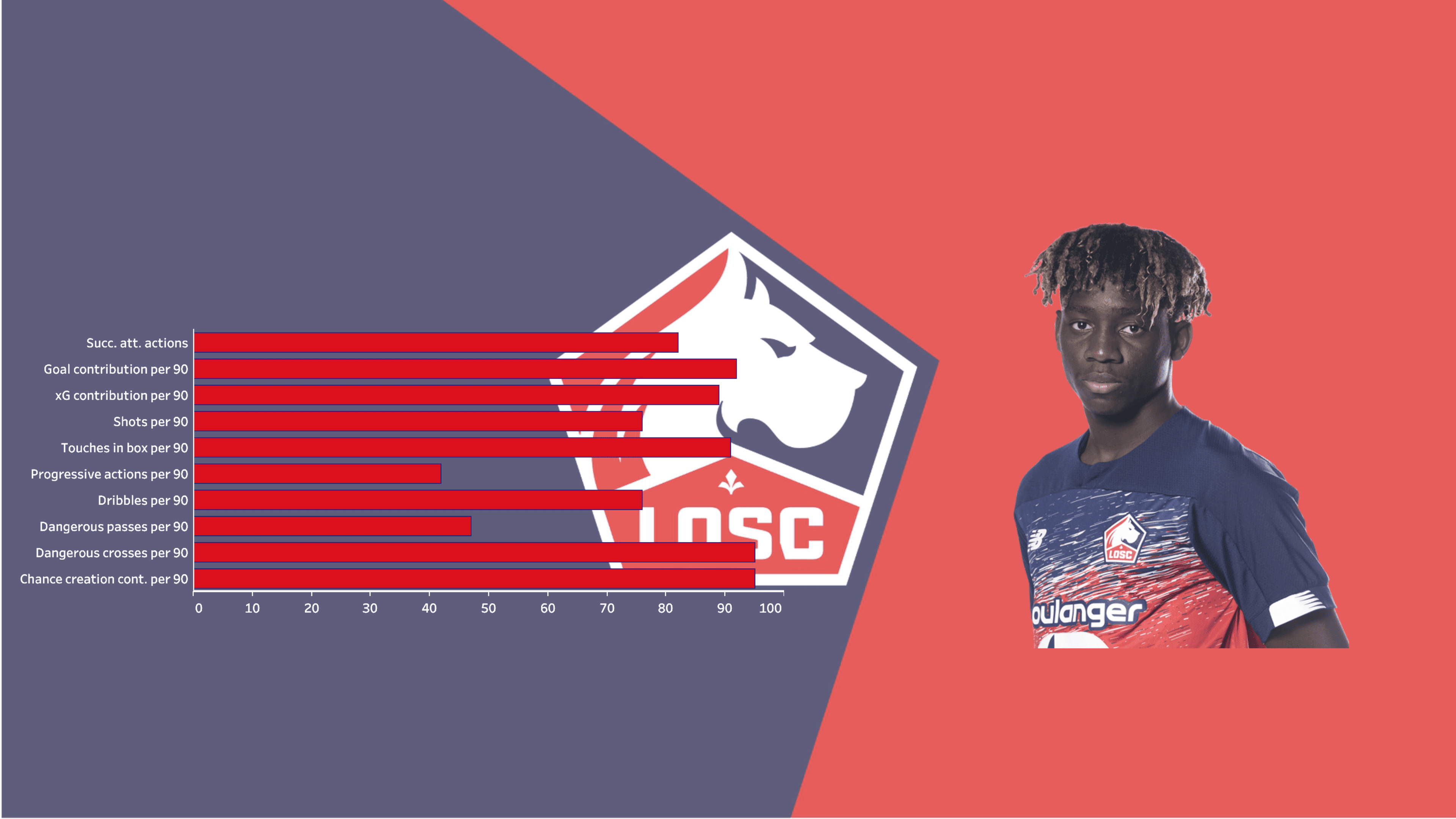
Maxime Wackers
Maxime Wackers is a 22-year-old French centre-back who can also play as a defensive midfielder. Wackers stood out during our analysis in the defending and passing sections and also showed good numbers in terms of progressive passes. This stats indicate he is a ball-playing defender capable of progressing the ball up the pitch and maintain possession for his team. Check his percentile ranks chart below to see what other metrics he ranks well in.
Standout attributes
- Defending
- Passing
- Ball progression
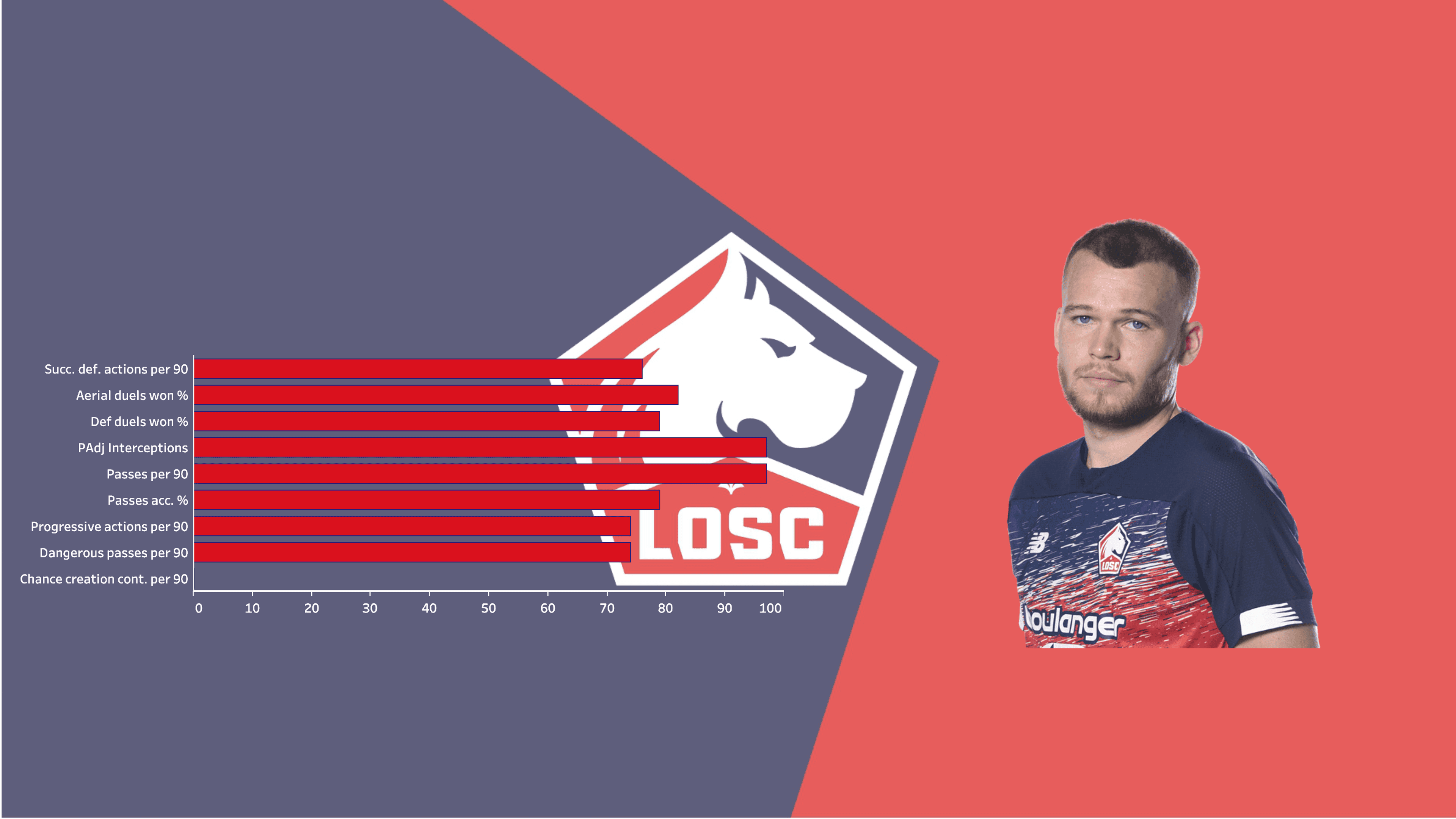
Ruben Droehnle
Ruben Droehnle is a 22-year-old French centre-back that can also play as a left-back. Droehnle was amongst the best in many of the sections of this analysis, defending, passing, ball creation and creativity. The young defender has a statistical profile of a good ball-playing defender that can cover the left side while also showing great defensive stats. Check his percentile ranks chart below to see what other metrics he ranks well in.
Standout attributes
- Defending
- Passing
- Ball progression
- Creativity

Cheikh Niasse
Cheikh Niasse is a 20-year-old defensive midfielder that can also play the role of centre-back. The youngster from Senegal was a regular standout in quite a few of the sections in our analysis, passing, ball progression and creativity were the areas where he stood out the most but he also has great defensive numbers. Check his percentile ranks chart below to see what other metrics he ranks well in.
Standout attributes
- Defending
- Passing
- Ball progression
- Creativity
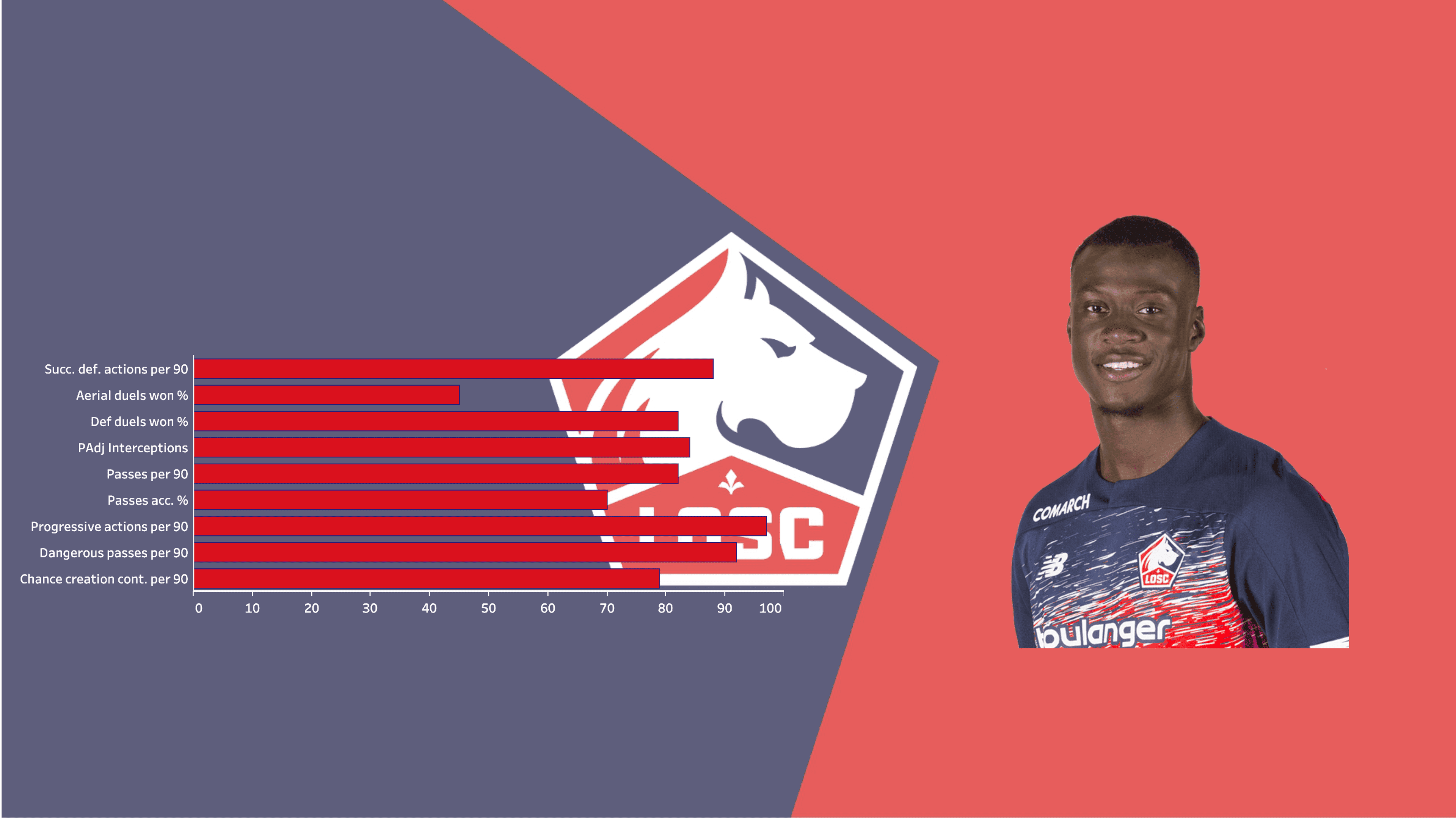
Conclusion
In this data analysis we were able to identify the talents in Lille’s academy who have the best statistical profile and therefore the best in terms of raw output. The data shows, however, that these five players had a significant contribution to Lille II’s team and show signs of being ready to take the next step. Although data analysis doesn’t give us a complete view of the player’s quality and needs to be complemented with gameplay analysis, it can be a very good indicator to identify strengths and weaknesses of a player as well as some aspects of his style of play.
Lille have something to be excited about when it comes to their academy players as there seem to be really talented players full of potential in their youth teams. If the club continues this philosophy of developing young players, and then actually give them the chance to play, then they will certainly benefit a lot.






Comments